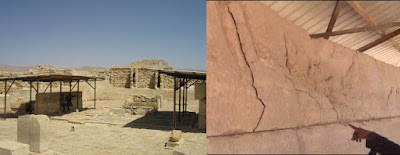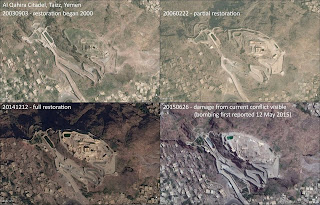Sunday, January 24, 2016 -  Almaqah Temple,Archaeology in Yemen,Sirwah
Almaqah Temple,Archaeology in Yemen,Sirwah
 No comments
No comments
 Almaqah Temple,Archaeology in Yemen,Sirwah
Almaqah Temple,Archaeology in Yemen,Sirwah
 No comments
No comments
A rose may be a rose, but an architectural pillar is not always the same archaeologically significant pillar
After posting a damage notification on Friday regarding the Bar'an Temple, also known as the Moon Temple in Ma'rib, Yemen, عرش بلقيس ARCA and Archaeology in Yemen received word late yesterday evening via text message that the images portrayed via multiple news outlets across Yemen and elsewhere in social media were not of the Bar'an Temple. With little more to go on besides, "the images are wrong" I and the administrator of Archaeology in Yemen set about reconfirming the details, as even well-meaning heritage professionals, who do our best to double and triple fact check before reporting, make mistakes.
Pouring through BBC and Youtube videos and hundreds of images and PDFs via the Sana'a Branch of the Orient Department of the German Archaeological Institute we now know the commenter was correct. Most importantly, we now know what site was depicted in the January 14, 2016 reports and have more details than we had at the time of the original reporting. For correction purposes, we will be leaving this re-identification notice up on both this and the original incorrect post pages so as to prevent any further misidentification.
The site damaged which was incorrectly identified as the Bar'an Temple (Moon Temple), Ma'rib, Yemen, عرش بلقيس is actually the Almaqah Temple in Ṣirwāḥ, Yemen معبد إلمقه.
One of the great religious centers of ancient Arabia, Sirwah, is located 120 km east of Sanaa and 40 km west of Ma'rib. The site is situated between the Yemeni highlands to the west and the Rub al Khali, or Empty Quarter to the east. This temple's location is thirty minutes by car away from the Bar'an Temple, or at least it would be, if you were travelling during peace time from one historically pillar-filled site to the other.
From January 14th through January 16, 2016 Saudi-led coalition warplanes resumed their airstrikes on Yemen. On Thursday, January 14th as many as 20 sorties were reported by witnesses and various regional news services and social media. Some of these engagements targeted the Sirwah district in the Ma’rib Province of Yemen and it is following those strikes that the damages to the Almaqah Temple in Ṣirwāḥ started to go public.
Details of the damage to the historic site can be seen in the video clip below and in the comparison photos found in this post. As has been reported time and time again, the air strikes in this conflict are not differentiating between military, civilian and archaeological targets and the result is both a humanitarian and historic catastrophe.
Details of the damage to the historic site can be seen in the video clip below and in the comparison photos found in this post. As has been reported time and time again, the air strikes in this conflict are not differentiating between military, civilian and archaeological targets and the result is both a humanitarian and historic catastrophe.
But even with this much documentation, we still cannot ascertain if this is new damage, or damages sustained earlier in the conflict as intensive airstrikes have been carried out in this region since Saudi-coalition troops pushed into the district in early October 2015. There were also earlier reports of some unidentified level of damage to the site on April 27, 2015 however we have not been able to date what happened to the site during what incident as of yet.
While the recent report of "new" damages came out on January 14, 2014 it was just a few short hours after that when Arabic news services started to get either the impacted site's name wrong or displayed the correctly named site but with incorrectly sourced photo imagery, which brings me back to my original a pillar is not a pillar statement. This is what makes site identification from the safety of a non conflict country difficult and why news sources closer to the engagement must be checked and rechecked by multiple sets of eyes for accuracy something that isn't always a perfect science when site identifications are being done by volunteers with limited time and resources at their disposal.
For the record, the news sources reporting the sites incorrectly are:
News of Yemen - Reported photos of the damage sustained at the Almaqah Temple but stated the site's name as The Queen of Sheba Temple in Marib.
Sa'ada News - Identified the Almaqah Temple correctly and stressing that the damages occurred on January 14, 2016, but carried a photo of the Bar'an Temple (Moon Temple), Ma'rib,
Yalmashhad News - Reported photos of the damage sustained at the throan of the Queen of Sheba in Marib using a photo of the Bar'an Temple (Moon Temple), Ma'rib,
Sana'a City - Identified the Almaqah Temple correctly, but carried no photo.
 |
| Almaqah Temple pillers in Sirwah, Yemen. NOTE: that large missing piece is already reflected in the upper earlier dated photo. This is not conflict damage. |
The Boulevard - Identified the Almaqah Temple correctly and stressing that the damages occurred on January 14, 2016. Carries a correct photo, though it is unclear if this if of damages or the excavation.
Almasirah News - Identified the Almaqah Temple correctly and carries a correct photo of the porticos six pillars.
Almasirah News - Identified the Almaqah Temple correctly and carries a correct photo of the porticos six pillars.
The temple in Sirwah is believed to have been dedicated to the Sabaean god Almaqah, whose temple's dedicatory inscription at Sirwah read ‘Ba’al Awa’el’,or "Master of the Ibex" which helps explain the continuous line of ibex heads found on external surfaces at the site.
Sadly the main tower, appears to be severely damaged by the force of the hit, which cracked an inscription dating back to the seventh century BCE. Damage have also been documented along the row of carved ibexes on the outside of its temple wall. Lastly, one of the portico's six misidentified pillars which appeared to have been damaged by the conflict is instead historically missing the dramatic chunk publicised across the web.
By: Lynda Albertson
Photos used for Identification in this report in order of presentation:
3D model - Abdelhafiz 2009
From Top to Bottom Mabkhot Mohtem, Almasirah.net, Tihamahnews
Left to right - Panaramio and News of Yemen
Top to Bottom - Sarah Rijziger-History Today and News of Yemen

























